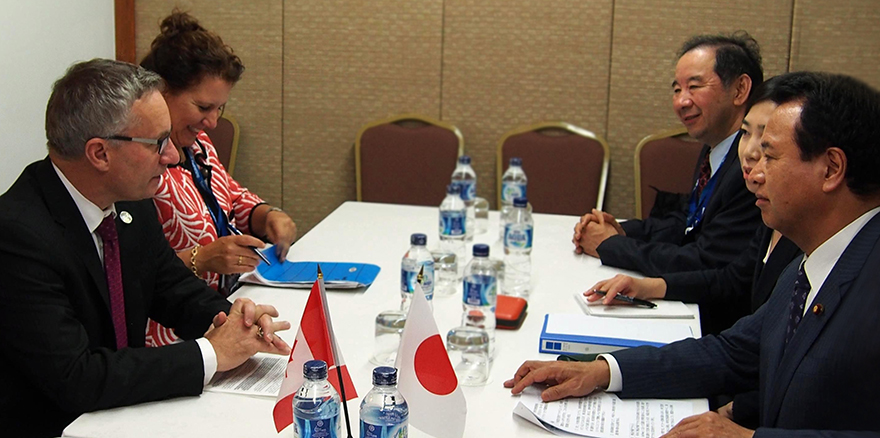
The Trans-Pacific Partnership (TPP) deal is a free trade agreement (FTA) signed by 12 countries bordering the Pacific ocean. It was finalised on 5th October 2015 after 5 years of intense negotiation. The countries that participated were: The United States, Australia, Brunei Darussalam, Canada, Chile, Japan, Malaysia, Mexico, New Zealand, Peru, Singapore, and Vietnam.
TPP is the expansion of the Trans-Pacific Strategic Economic Partnership Agreement (TPSEP or P4) signed in the year 2005 between Brunei, Chile, New Zealand and Singapore.
The TPP will reduce trade barriers between the member countries by cutting tariffs on almost all goods traded. TPP is the most ambitious Free Trade Agreement (FTA) ever formed. If the agreement is ratified by all the individual member countries, it will be the largest FTA in the world. The TPP member countries represent 40 % of the total world’s GDP.
Apart from reducing tariff barriers, the deal includes other things also such as stricter labour and environmental rules, rigid Intellectual Property Rights (IPR) rules, the establishment of Investor-state dispute settlement mechanism etc. If a TPP member country fails to adhere to the rules laid out in the agreement, foreign investors can seek arbitration through the investor-state dispute settlement mechanism established for this purpose.
This deal has been seen by analysts as USA’s strategy to tackle China’s dominance in Asia and also to impose its rules on IPR etc. on the world.
It has to be noted that the text of the agreement is not yet in the public domain. Most of the analysis is based on the documents leaked by Wikileaks. TPP attracted much of its criticism because of the fact that it was carried out in secrecy.
Impact of TPP on India
India’s export competitiveness with regard to countries like the US, Japan and Canada might decline. This is because the US and Japan will have almost zero tariffs for TPP members like Vietnam, Malaysia etc. and India will lose market to these countries. It has been estimated that India will face a trade diversion of almost 1 % if TPP is ratified. As per the rating agency India Ratings and Research, India’s textile exports will suffer the most.
India’s textile and apparels export to the US, Japan and Canada stood at $11.5 billion in 2014-15 which is likely to reduce due to TPP. Vietnam would be a key beneficiary as it the second-largest garment exporter in the world. The US normally imposes a duty of 15 % to 50 % on textile, but it will be zero for Vietnam as it a member of TPP.
But, to be eligible for zero duty on textile there is a condition called “yarn-forward rule’ in the TPP agreement. It means the yarn used in the manufacture of textile and garment should be produced by a TPP member. So if Vietnam wants to avail zero duty in the US, it will either have to produce yarn in Vietnam or import it from other TPP member country. Currently, there is a lack of sufficient capacities of yarn/fabric in TPP member countries. This could give a relief to India. But, if these countries decide to develop yarn facilities, in the long run, it can impact exports of yarn/ fabric also.
TPP can impact foreign investment in India. These investors would find it profitable to manufacture in TPP member country so as to be able to export at zero duty to the USA, Japan etc.
TPP has been perceived as a strategy by the US to impose its policies on the world. It is possible that the US would want to use TPP as a blueprint in the bilateral treaty it is negotiating with India. Effective implementation of TPP will reduce India’s bargaining power.
The most controversial policy of TPP is stringent Intellectual Property Rights. (IPRs). If pharmaceutical companies are given more patent protection for drugs, it would become difficult to produce low-cost generic drugs like it is done in India at present. It would affect India’s generic pharmaceutical industry and increase health cost for the country.
The respite is that the agreement could take another one or two years to be in place as it has to be ratified by individual countries. India should brace itself for the world post-TPP. It should pursue other Free Trade Agreements (FTAs) to minimise the impact of TPP. India is currently in negotiation for treaties with the European Union and the US. It is also a part of the on-going Regional Comprehensive Economic Partnership (RCEP) deal between ASEAN members.
In the end, TPP is clearly a move by the US to assert its dominance and isolate countries like India on IPR. Barack Obama made this statement on the TPP, “When more than 95 percent of our potential customers live outside our borders, we can’t let countries like China write the rules of the global economy. We should write those rules, opening new markets to American products while setting high standards for protecting workers and preserving our environment. That’s what the agreement reached today in Atlanta will do. Trade ministers from the 12 nations that make up the Trans-Pacific Partnership finished negotiations on an agreement that reflects America’s values and gives our workers the fair shot at the success they deserve.”